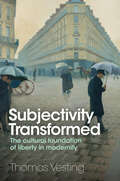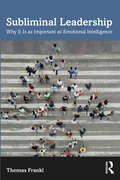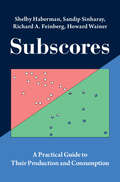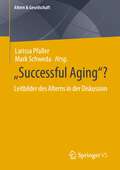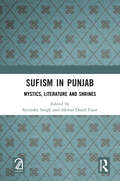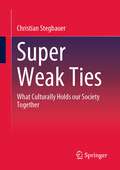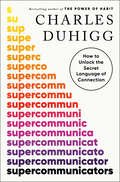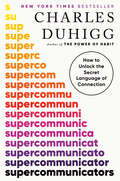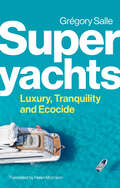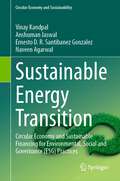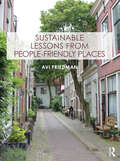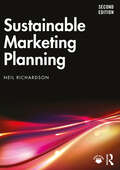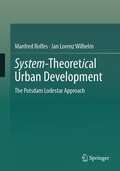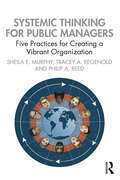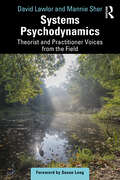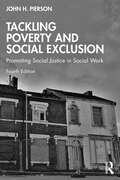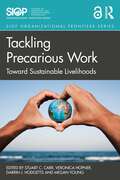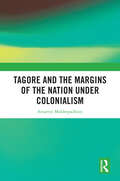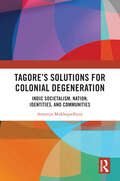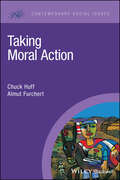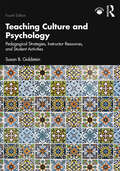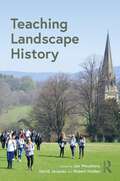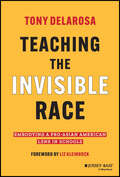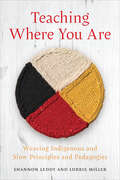- Table View
- List View
Subjectivity Transformed: The Cultural Foundation of Liberty in Modernity
by Thomas VestingThis book provides a historically informed reconstruction of the social practices that have shaped the formation of the modern subject from the early modern period to the present. The formal legal protections accorded to subjects are, and always have been, latent in social practices, norms, and language before they are articulated in formal legal orders. Vesting argues that in Western societies legal personhood is closely tied to three ideal types of social personhood – what he calls the gentleman, the manager, and Homo digitalis. By examining these three ideal types and their emergence in society, we can see that Western formal law does not bring these ideal types into being but, on the contrary, they arise from the social and cultural conditions that they generate and reflect. Correspondingly, Western legal personhood, or “legal subjectivity,” arises from the history and culture of Western nations, not the other way around. Therefore, signature features of Western formal law, particularly its valorization of the rights of persons (whether natural or nonnatural), come from the particular sociohistorical cultural developments that had already generated the strong ideas of social personhood inherent in the ideal types of the gentleman, the manager, and Homo digitalis. Subjectivity Transformed is a major contribution to legal and social theory and, with its original analysis of the formation of modern subjectivity, it will be of interest to students and scholars throughout the social sciences and humanities.
Subliminal Leadership: Why It Is as Important as Emotional Intelligence
by Thomas FranklUnderstanding the power of subliminal influence makes or breaks leaders. What is it that subliminally motivates people to give their best, not just what’s in their job description? How do you build an outstanding team? (Spoiler: it’s not just by putting the best people in a team.) The answer lies in the power of subliminal influence. This book explains in a clear and accessible way this important, yet little known and understood, area of psychology and leadership. As Emotional Intelligence helped managers and leaders to understand the importance of empathy in the workplace, Subliminal Leadership takes us to the next level by explaining how influence through non-verbal communication mostly happens below the threshold of our conscious awareness: subliminal forms of body language and communication which influence other people's attitudes, thinking and behavior – and which may boost, or undermine a leader's authority, the performance of teams or the quality of key customer relationships. Readers will learn how we unconsciously communicate and how we positively or negatively influence other people in the process. Understanding subliminal influence will help people in, or aspiring towards, leadership positions to build trust, understand others’ emotions, make better decisions, and strengthen professional relationships. Based on recent scientific research in disciplines as diverse as psychology, evolutionary biology, anthropology, medicine, neuroscience, and management studies, the book offers a breakthrough, multidisciplinary approach to influence and leadership. This book is for everyone interested in the psychological, biological, and medical dimensions of leadership.
Subscores: A Practical Guide to Their Production and Consumption
by null Shelby Haberman null Sandip Sinharay null Richard A. Feinberg null Howard WainerThis authoritative guide directs consumers and users of test scores on when and how to provide subscores and how to make informed decisions based on them. The book is designed to be accessible to practitioners and score users with varying levels of technical expertise, from executives of testing organizations and students who take tests to graduate students in educational measurement, psychometricians, and test developers. The theoretical background required to evaluate subscores and improve them are provided alongside examples of tests with subscores to illustrate their use and misuse. The first chapter covers the history of tests, subtests, scores, and subscores. Later chapters go into subscore reporting, evaluating and improving the quality of subscores, and alternatives to subscores when they are not appropriate. This thorough introduction to the existing research and best practices will be useful to graduate students, researchers, and practitioners.
“Successful Aging”?: Leitbilder des Alterns in der Diskussion (Altern & Gesellschaft)
by Larissa Pfaller Mark SchwedaDer vorliegende Band versammelt zentrale Perspektiven der deutschsprachigen Alternsforschung auf Successful Aging. Ziel ist es, die wissenschaftliche Begründung, gesellschaftliche Bedeutung, moralische Akzeptabilität und politische Legitimität zeitgenössischer Leitbilder des Alter(n)s kritisch unter die Lupe zu nehmen. Dabei beleuchten die Beiträge insbesondere, welche Verständnisse des Alter(n)s den verschiedenen Ansätzen und Spielarten gelingenden Alterns zugrunde liegen, welche Leitbilder mit ihnen Einzug in wissenschaftliche Debatten und politische Auseinandersetzungen halten und in welcher Beziehung sie zu alltagsweltlichen Erfahrungen älterer Menschen sowie zu philosophisch-ethischen Theorien eines guten Lebens im Alter stehen.
Sufism in Punjab: Mystics, Literature and Shrines
by Surinder Singh Ishwar Dayal GaurThis anthology is a collective endeavor of scholars from India and Pakistan devoted to Sufi mystics, literature and shrines with a detailed introduction. The essays explore the methods adopted by the Punjab Sufis to popularize the mystic ideology and praxis in the medieval socio-cultural milieu. These writings also delve into the different genres of Sufi literature, both in the elite and vernacular languages, intending to appreciate the nuances of Punjab Sufism. Apart from the architectural features of the Sufi shrines, the anthology attempts to illumine the organic linkages between these institutions and the Punjabis and, thus, underscore the Sufi non-communitarian devotion as a primary ingredient of the Punjabi cultural fusion. This title is co-published with Aakar Books. Print editions not for sale in South Asia (India, Sri Lanka, Nepal, Bangladesh, Pakistan and Bhutan)
Super Weak Ties: What Culturally Holds our Society Together
by Christian StegbauerIn this book, it is explained how we learn from each other and how people adapt their behavior to one another. We orient ourselves to others by observing how they behave in specific situations. The analysis of relationships is actually the domain of network research, which has traditionally focused on strong and weak ties. However, this book explores super weak ties, which are often not consciously perceived, as their significance unfolds behind the backs of us all. Although one can hardly speak of relationships in the traditional sense, these super weak ties are often just as influential as stronger ones. The orienting effect is particularly pronounced when there are similarities in interests and situations between observers and those being observed. Without transmissions facilitated by super weak ties, it would be challenging to arrive at cultural commonalities in society.
Supercommunicators: How to Unlock the Secret Language of Connection
by Charles DuhiggFrom the Globe and Mail and New York Times bestselling author of The Power of Habit, an investigation of what makes conversations work, and how we can all learn to be supercommunicators at work and in our lives.We all know people who seem capable of connecting with almost anyone. They are the ones we turn to for advice, the ones who ask deep questions but who also seem to hear what we are trying to say. What do they know about conversation that makes them so special? And what can they tell us about how communication really works?Supercommunicators, Charles Duhigg argues, understand—some by intuition, some by hard-won experience—that there is a science to how human beings connect through words. They understand that whenever we speak, we're actually participating in three distinct conversations: What is this really about? How do we feel? And who are we? They know the importance of recognizing—and then matching—each kind of conversation, and how to hear the complex emotions, subtle negotiations and hidden beliefs that color and inform everything we say. Our pasts, our values, our affiliations—our identities—shape every discussion we have, from who will pick up the kids to how we want to be treated at work.With his trademark insight and clarity, Duhigg shows readers how to recognize these three conversations—and teaches us the skills we need to navigate them more successfully. Communication, he argues, is a superpower. By bringing readers into jury deliberations and fraught CIA recruitments, into Netflix's company-wide conversations about equity and the writers' room of The Big Bang Theory, we learn why some people are able to make themselves heard—and to hear others—so clearly. We learn how to recognize and leverage the hidden layers that lurk beneath every conversation. In the end, we learn a simple but powerful lesson: We can connect with anyone, as long as we understand how conversations work.
Supercommunicators: How to Unlock the Secret Language of Connection
by Charles DuhiggNEW YORK TIMES BESTSELLER • From the author of The Power of Habit, a fascinating exploration of what makes conversations work—and how we can all learn to be supercommunicators at work and in life&“A winning combination of stories, studies, and guidance that might well transform the worst communicators you know into some of the best.&”—Adam Grant, author of Think Again and Hidden PotentialCome inside a jury room as one juror leads a starkly divided room to consensus. Join a young CIA officer as he recruits a reluctant foreign agent. And sit with an accomplished surgeon as he tries, and fails, to convince yet another cancer patient to opt for the less risky course of treatment. In Supercommunicators, Charles Duhigg blends deep research and his trademark storytelling skills to show how we can all learn to identify and leverage the hidden layers that lurk beneath every conversation.Communication is a superpower and the best communicators understand that whenever we speak, we&’re actually participating in one of three conversations: practical (What&’s this really about?), emotional (How do we feel?), and social (Who are we?). If you don&’t know what kind of conversation you&’re having, you&’re unlikely to connect. Supercommunicators know the importance of recognizing—and then matching—each kind of conversation, and how to hear the complex emotions, subtle negotiations, and deeply held beliefs that color so much of what we say and how we listen. Our experiences, our values, our emotional lives—and how we see ourselves, and others—shape every discussion, from who will pick up the kids to how we want to be treated at work. In this book, you will learn why some people are able to make themselves heard, and to hear others, so clearly.With his storytelling that takes us from the writers&’ room of The Big Bang Theory to the couches of leading marriage counselors, Duhigg shows readers how to recognize these three conversations—and teaches us the tips and skills we need to navigate them more successfully.In the end, he delivers a simple but powerful lesson: With the right tools, we can connect with anyone.
Superyachts: Luxury, Tranquility and Ecocide
by Gregory SalleA superyacht is a boat that exceeds 30 metres in length, with some surpassing even 100 metres—more than a football field. At the beginning of the twenty-first century, there were about 2,000 of these vessels in the world; two decades and a financial crisis later, there are three times as many. Grégory Salle argues that these are not whimsical fads: on the contrary, luxury yachting highlights the social exclusivity of the wealthiest and the environmental waste they emit. Rather than being simply the plaything of billionaires with extravagant lifestyles, the superyacht offers a disconcerting reflection of the world as it is. A contemporary form of ostentatious seclusion, a magnifying glass for social inequalities, the superyacht leads us straight to the great questions of our time, including the question of ecocide. From class struggle to the over-consumption of the rich, from tax evasion to environmental crime, from eco-bleaching to the differential management of illegalities, to pull the thread of super yachting is to unspool the whole ball of capitalism.
Supportive Smart Homes: Their Role in Aging in Place (Synthesis Lectures on Technology and Health)
by Frank Knoefel Bruce Wallace Neil Thomas Heidi Sveistrup Rafik Goubran Christine L. LaurinSignificant health-industry human resource needs increase the reliance on family and friends to support older adults hoping to age in place. This book explores how recent improvements in integrated home technologies have the potential to address those challenges. The book considers how embedded home sensors can be used to monitor the health and wellbeing of older adults and how that can be used to assist with supporting safety and well-being. The content is designed to help multiple stakeholders in the supportive smart home space to better understand the complexity of this field and the need for transdisciplinary collaboration. These stakeholders include the older adults who will benefit from supportive smart home technology; informal and formal caregiver and healthcare professionals concerned about the older adult’s well-being; researchers from multiple disciplines in the supportive smart home area and their funders; companies looking to develop solutions and services or expand their offerings; policy makers who want to ensure privacy and equity in access and a successful integration of these technologies into the evolving health and social services sectors; and students, the future leaders in AgeTech. Overall, the intent of the book is to inspire engineers, computer scientists, industrial designers, clinicians and healthcare providers, social scientists, students, policy makers, and older adults and their caregivers to collaborate in advancing the supportive smart home space to develop more options for aging in place.
Sustainable Energy Transition: Circular Economy and Sustainable Financing for Environmental, Social and Governance (ESG) Practices (Circular Economy and Sustainability)
by Vinay Kandpal Anshuman Jaswal Ernesto D.R. Santibanez Gonzalez Naveen AgarwalThe book offers a comprehensive overview of the challenges and opportunities associated with the transition to sustainable energy, circular economy, and sustainable financing for ESG practices. The publication is needed at this time because the world is facing urgent environmental and social challenges, such as climate change, resource depletion, and social inequality, which require a fundamental transformation of our economic and social systems. The transition to sustainable energy, circular economy, and sustainable financing for ESG practices offers a promising pathway to address these challenges and achieve sustainable development goals.The purpose of the publication is to provide a holistic and practical guide for policymakers, business leaders, investors, and other stakeholders who are interested in advancing sustainable energy, circular economy, and ESG practices. The book covers a range of topics, including the drivers of the transition, policy frameworks and regulations, technology and innovation, business models and financial instruments, and the role of stakeholders in facilitating the transition. It also emphasizes the importance of integrated approaches that balance economic, social, and environmental objectives, and provides practical examples and case studies of successful sustainable energy, circular economy, and ESG practices from around the world.The new contribution of this publication is its interdisciplinary and practical approach to sustainable energy, circular economy, and ESG practices. The book draws on the latest research from various fields, including economics, engineering, environmental science, and social science, and provides a synthesis of best practices and lessons learned from a diverse range of stakeholders, such as governments, businesses, and civil society organizations. The publication also provides a roadmap for how stakeholders can work together overcome the challenges of the transition and create a more sustainable and equitable future.The book is a timely and essential guide for anyone who is interested in advancing sustainable development goals. The book provides a comprehensive overview of the challenges and opportunities associated with the transition to sustainable energy, circular economy, and sustainable financing for ESG practices and offers practical solutions and case studies from around the world. Its interdisciplinary and practical approach makes it a valuable resource for policymakers, business leaders, investors, and other stakeholders who are committed to creating a more sustainable and equitable future.
Sustainable Lessons from People-Friendly Places
by Avi FriedmanCurrent planning and design modes of cities are facing challenges of philosophy and form. Past approaches no longer sustain new demands and call for innovative thinking. In a world that is becoming highly urbanized, the need for a new outlook is propelled by fundamental global changes that touch upon environmental, economic and social aspects.The book introduces fundamental principles of timely sustainable urban design, paying attention to architecture, integration of natural features, public urban spaces and their successful use. Readers will learn how cities are transitioning to active mobility by placing the wellbeing of citizens at the heart of planning; making buildings fit nature; supporting local culture through preservation; and including community gardens in neighborhoods, among others. Written by a practicing architect, professor and author, the book is richly illustrated and features meticulously selected international case studies.
Sustainable Marketing Planning
by Neil RichardsonThis book provides practical insights, tools and frameworks to help readers produce tactically and strategically appropriate marketing plans.Showing how to embed sustainability in these plans, students will be shown how to implement changes while being encouraged to reflect on why they are needed. The text reflects on contemporary themes that impact on sustainable marketing planning, including consumer behaviour, entrepreneurialism, internal marketing, services, international marketing, event management and digital marketing. The second edition has been fully updated with a greater focus on the issues surrounding sustainability, including the environmental challenges facing businesses, sustainable accreditation and integrating the UN SDGs. It provides background on the value discourses that underpin sustainability, incorporates new examples and case studies from broader regions around the world and introduces TBL-based loyalty. Full of tools and frameworks to improve comprehension, including chapter-by-chapter learning outcomes, summaries, exercises, applied activities and mini case studies, it bridges the gap between theory and practice effectively and accessibly.Presenting contemporary themes and challenges at the cutting edge of business research and practice, this book provides core reading for advanced undergraduate and postgraduate students of sustainable marketing, marketing planning and marketing strategy, as well as professionals seeking to improve the competitive advantage of their organisations.Online resources for the use of instructors include PowerPoint lecture slides and a multiple choice questions section.
System-Theoretical Urban Development: The Potsdam Lodestar Approach
by Manfred Rolfes Jan Lorenz WilhelmIn their book, the authors introduce the topic of urban development from a systems (theoretical) perspective and provide explanatory approaches, tips and methodological instructions for dealing with urban complexity. Knowing full well that this sometimes amounts to squaring the circle, the authors draw on applied systemic approaches and systematically couple these with epistemological currents that can be assigned to Luhmann's systems theory. The social understanding of this theory of social systems represents a very good starting point for understanding urban development and urban complexity. From this perspective, urban development can be seen as a process in which organisations and individuals with their own expectations and perspectives are involved, in which contradictions and conflicts seem inevitable and the future cannot be clearly predicted. Decisions in cities and municipalities are therefore always associated with risks, irritations and unexpected consequences. With the Potsdam lodestar approach, Rolfes and Wilhelm present a multidimensional approach to managing urban development processes. The approach distinguishes five process dimensions, which are presented chapter by chapter and linked with recommendations. The individual chapters are structured along guiding questions and feature appealing visualizations and numerous bonus materials.
Systemic Thinking for Public Managers: Five Practices for Creating a Vibrant Organization
by Sheila Murphy Tracey Regenold Philip ReedOffering a pathway to vibrant organizations, this book integrates systems thinking, critical thinking, and design thinking, and provides the tools needed to proactively apply them in the social systems where we live and work. Systemic thinking—the combination of systems thinking, critical systems thinking, and design thinking—provides a way of addressing the complexity of problems faced by public sector managers. Far too often systemic thinking has been discussed theoretically rather than practically. This book changes that, enabling public sector managers and leaders to connect staff, partners, and stakeholders in the pursuit of thoughtfully designed and responsive service. Clearly written and designed to be put to immediate use on the job, each chapter provides a discussion of one specific practice. Included are guiding principles, a case study, relevant practical tools, and suggestions of for additional practice and reading.Using this book, managers of social systems such as public welfare, healthcare, public schools and libraries, housing and community development, and students of public administration will gain a deeper understanding of organizational systems and design, and a new toolkit to fortify their own organizations.
Systems Psychodynamics: Theorist and Practitioner Voices from the Field
by David Lawlor Mannie SherThrough a series of in-depth interviews with Tavistock thinkers across three generations, this volume illustrates the practice and application of the systems psychodynamics paradigm to organisational development consultancy, research and training. Across 28 stimulating interviews with a group of international consultants, interviewees present a critical appraisal of the systems psychodynamics paradigm and its application to present-day social and organisational difficulties. By using a narrative interpretive method, the interviewers attend to the historical, psychosocial and biographical dynamics of the interviewees’ approaches and methods of work, and address several areas of organisational consultancy. These include organisational design, the division of labour, levels of authority and reporting relationships; the nature of work tasks, processes and activities; primary tasks and the inevitable unconscious dynamics within systems and individuals. The multi-disciplinary approaches of the interviewees will interest managers, policymakers, consultant practitioners and researchers to understand the variety of applications of systems psychodynamics methodologies.
Tackling Poverty and Social Exclusion: Promoting Social Justice in Social Work
by John H. PiersonIn highly unequal Britain, poverty and social exclusion continue to dominate the lives of users of social work and social care services. At the same time, years of austerity combined with welfare reform have changed the context in which services are delivered in a society roiled by Brexit, Covid, Black Lives Matter and women rallying under the banner, “Me‑too”.This fourth edition lays out the ways and means for practitioners to tackle the deprivation and destitution of service users. Fully revised and expanded, it introduces new material that tracks changes and developments in policy and practice. Statutes, benefit rules and relevant research are discussed as part of the necessary knowledge base for practitioners. Greater attention than in previous editions is paid to: local authority commissioning, the impact of social media on the mental health of young people, substandard housing and working with transgender youth.Preparing practitioners to engage directly with the social and personal circumstances facing excluded individuals and their families, this book explains the development of the concept of social exclusion as a framework for understanding the impact of poverty and other deprivations in users’ lives, and locates that framework within social work values of social justice while acknowledging the many challenges to those values. The focus is on practice throughout with boxed extracts from key policies and guidelines along with questions for readers to ponder through up‑to‑date examples, activities and exercises in each chapter. Case studies from public, private and voluntary sectors are drawn from across the United Kingdom, to illuminate the way forward for poverty‑aware social work.Tackling Poverty and Social Exclusion will be required reading for all BA and MA social work degrees across the United Kingdom.
Tackling Precarious Work: Toward Sustainable Livelihoods (SIOP Organizational Frontiers Series)
by Stuart C. Carr Veronica Hopner Darrin J. Hodgetts Megan YoungTackling precarious work has been described by the United Nations (UN)’s International Labour Organization (ILO) as the main challenge facing the world of work. In this ground-breaking book, leading applied research scholars, advocates, and activists from across the globe respond to this challenge by showing how Industrial and Organizational (I/O) psychology has a significant contribution to make in humanity moving away from precarious work situations towards sustainable livelihoods. Broken down into four key parts on Sustainable Livelihoods, Fair Incomes, Work Security and Social Protection, the book covers a multitude of topics including the role of poor pay, lack of work-related security, social protection for human health and wellbeing, and interventions and policies to implement for the future of work. The volume offers a detailed look into useful and effective ways to tackle precarious work to create and maintain sustainable livelihoods. This curated collection of 22 chapters considers the broader relationships between previous research work and issues of human security and sustainability that affect workers, families, communities, and societies. Each chapter expands the present understandings of the world of precarious work and how it fits within broader issues of economic, ecological, and social sustainability. In addition to I/O psychologists in research, practice, service and study, this book will also be useful for organizational researchers, labor unions, HR practitioners, fair trade, cooperative, and civil society organizations, social scientists, human security analysts, public health professionals, economists, and supporters of the UN SDGs, including at the UN.
Tagore and the Margins of the Nation under Colonialism
by Amartya MukhopadhyayThis book focuses on India’s anti-colonial politics which Rabindranath Tagore (1861–1941) brought into the mainstream of nationalist thinking. It browses through the entire corpus of Tagore’s writings in the genres of poetry, fiction, and essays, to glean both used and hitherto unused/un-translated writings that illumine Tagore’s gender consciousness and (proto)feminist thought and empathy, presenting it in a wholly new light. It teases out Tagore’s original views on India’s industrial-capitalist development and his views on the roles of applied scientists and engineers in it to highlight his critique of the nature of science teaching in colonial India. The volume also delineates Tagore’s Upanişadic ecologism that creatively evoked anticolonialism and patriotism. Lucid and topical, the book will be indispensable for students and researchers in the fields of comparative literature, history, political science, international relations, and sociology at all levels, and anybody interested in literary criticism and cultural studies.
Tagore’s Solutions for Colonial Degeneration: Indic Societalism, Nation, Identities, and Communities
by Amartya MukhopadhyayThis book focuses on Rabindranath Tagore as a social and political thinker revolving around Tagore’s ideas on the seeds of civil society, nation, identities, and communities in the Indic tradition. The author deconstructs Tagore’s concepts against the appropriate resurgent and triumphalist Western concepts in the updated Western social thought and theories. The book examines Tagore’s understanding of the nature of the civil social sphere in India and analyzes the relevance of his civil social concepts against the backdrop of colonialism in India. It also discusses his views on nation and nationalism in India and his insights into the problems and prospects of intercommunity, particularly Hindu-Muslim relations in India. Applying current social science and Western literature in an unprecedented manner to interpret Tagore, this book will be of great interest to scholars, teachers, and students of politics, nationalism, postcolonialism, history, comparative literature, sociology, religious studies, and South Asian studies.
Taking Moral Action (Contemporary Social Issues)
by Chuck Huff Almut FurchertProvides a systematic framework for understanding and shaping moral action Taking Moral Action offers a timely and comprehensive overview of the emerging field of moral psychology, introducing readers to one of the most vibrant areas of research in contemporary psychology. With an inclusive and interdisciplinary approach, authors Chuck Huff and Almut Furchert incorporate a wide range of scholarly traditions, philosophical theories, empirical findings, and practical moral writings to explore the complex network of influences, contexts, and processes involved in producing and structuring moral action. Integrating key empirical and theoretical literature, this unique volume helps readers grasp the different aspects of both habitual and intentional acts of moral action. Thematically organized chapters examine moral action in contexts such as evolution, moral ecology, personality, moral identity and the self, moral reason, moral emotion, and more. Each chapter features a discussion of how neuroscience underlies or supports the influence and process addressed. Throughout the book, historical stories of moral action and examples of humanistic and experiential traditions of moral formation highlight what is possible, relevant, and appropriate in taking moral action in a variety of settings. Explores the relationships between moral psychology, empirical psychology, philosophy, and theology Considers the various ways that individuals experience and construct moral identity Emphasizes the practical application of the science of morality in service of moral good Reviews cultural, organizational, group, and social influences to investigate how individuals actively shape their moral environment Discusses the role of emotions in morality and considers if individuals can change or train their emotional responsesTaking Moral Action is essential reading for those new to the field and experienced practitioners alike. Containing extensive references and links to further readings, Taking Moral Action is also an excellent textbook for college and university courses in areas such as psychology, ethics, theology, philosophy, anthropology, and neuroscience.
Teaching Culture and Psychology: Pedagogical Strategies, Instructor Resources, and Student Activities
by Susan B. GoldsteinThe fourth edition of Teaching Culture and Psychology (previously Cross-Cultural Explorations) provides an array of carefully designed instructor resources and student activities that support the construction and implementation of courses on culture and psychology.Revised and expanded from previous editions, the book enables instructors to use selected activities appropriate for their course structure. Part One explores a variety of pedagogical challenges involved in teaching about culture and psychology and details specific strategies for addressing these challenges. Part Two (instructor resources) and Part Three (student handouts) center around 90 activities designed to encourage students to think critically about the role of culture in a wide range of psychology content areas. These activities are based on current and classic cross-cultural research and take the form of case studies, self-administered scales, mini-experiments, database search assignments, and the collection of content-analytic, observational, and interview data. For each activity, instructors are provided with a lecture/discussion module as well as suggestions for variations and expanded writing assignments. Student handouts are available in this text as well as on the Routledge website as fillable forms.Contributing to the inclusion of cultural perspectives in the psychology curriculum, this wide-ranging book enables instructors to provide students with hands-on experiences that facilitate the understanding and application of major concepts and principles in the study of culture and psychology, making it ideal for cultural psychology, anthropology, sociology, and related courses.
Teaching Landscape History
by Jan Woudstra David JacquesLandscape history is changing in content and style to address the issues of today. Experienced teachers and authors on the history of gardens and landscapes come together in this new volume to share ideas on the future of teaching history in departments of landscape architecture, archaeology, geography and allied subjects. Design history remains important, but this volume brings to the fore the increasing importance of environmental history, economic history, landscape history, cultural landscapes, environmental justice and decolonisation, ideas of sustainability and climate change amelioration, which may all be useful in serving the needs of a widening range of students in an increasingly complex world. The main themes include: what history should we narrate in the education of landscape architects? how can we recognise counter-narratives and our own bias? how should we engage the students in the history of their chosen profession? how can designers and researchers be persuaded of the relevance of history teaching to theory and practice? and what resources do we need to develop teaching of landscape histories? This book will be of interest to anyone teaching courses on landscape architecture, urban design, horticulture, garden design, architectural history, cultural geography and more.
Teaching the Invisible Race: Embodying a Pro-Asian American Lens in Schools
by Tony DelaRosaTransform How You Teach Asian American Narratives in your Schools! In Teaching the Invisible Race, anti-bias and anti-racist educator and researcher Tony DelaRosa (he, siya) delivers an insightful and hands-on treatment of how to embody a pro-Asian American lens in your classroom while combating anti-Asian hate in your school. The author offers stories, case studies, research, and frameworks that will help you build the knowledge, mindset, and skills you need to teach Asian-American history and stories in your curriculum. You’ll learn to embrace Asian American joy and a pro-Asian American lens—as opposed to a deficit lens—that is inclusive of Brown and Southeast Asian American perspectives and disability narratives. You’ll also find: Self-interrogation exercises regarding major Asian American concepts and social movements Ways to center Asian Americans in your classroom and your school Information about how white supremacy and anti-Blackness manifest in relation to Asian America, both internally and externallyAn essential resource for educators, school administrators, and K-12 school leaders, Teaching the Invisible Race will also earn a place in the hands of parents, families, and community members with an interest in advancing social justice in the Asian American context.
Teaching Where You Are: Weaving Indigenous and Slow Principles and Pedagogies
by Shannon Leddy Lorrie MillerTeaching Where You Are offers a guide for non-Indigenous educators to work in good ways with Indigenous students and provides resources across curricular areas to support all students. In this book, two seasoned educators, one Indigenous and one settler, bring to bear their years of experience teaching in elementary, secondary, and post-secondary contexts to explore the ways in which Indigenous and Slow approaches to teaching and learning mirror and complement one another. Using the holistic framework of the Medicine Wheel, Shannon Leddy and Lorrie Miller illustrate the ways in which interdisciplinary thinking, a focus on experiential learning, and the thoughtful application of the 4Rs – Respect, Relevance, Reciprocity, and Responsibility – can bring us back to the principle of teaching people, not subjects. Bringing forth the ways in which colonialism and cognitive imperialism have shaped Canadian curriculum and consciousness, the book offers avenues for the development of decolonial literacy to support the work of Indigenizing education. In considering the importance of engaging in decolonizing and Indigenizing approaches to education through Slow and Indigenous pedagogies using the lens of place-based and land-based education, Teaching Where You Are presents a text useful for teachers and educators grappling with the ongoing impacts of colonialism and the soul-work of how to decolonize and rehumanize education in meaningful ways.
